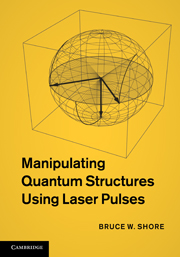Book contents
- Frontmatter
- Contents
- Preface
- Acknowledgments
- 1 Introduction
- 2 Atoms as structured particles
- 3 Radiation
- 4 The laser–atom interaction
- 5 Picturing quantum structure and changes
- 6 Incoherence: Rate equations
- 7 Coherence: The Schrödinger equation
- 8 Two-state coherent excitation
- 9 Weak pulse: Perturbation theory
- 10 The vector model
- 11 Sequential pulses
- 12 Degeneracy
- 13 Three states
- 14 Raman processes
- 15 Multilevel excitation
- 16 Averages and the statistical matrix (density matrix)
- 17 Systems with parts
- 18 Preparing superpositions
- 19 Measuring superpositions
- 20 Overall phase; interferometry and cyclic dynamics
- 21 Atoms affecting fields
- 22 Atoms in cavities
- 23 Control and optimization
- Appendix A Angular momentum
- Appendix B The multipole interaction
- Appendix C Classical radiation
- Appendix D Quantized radiation
- Appendix E Adiabatic states
- Appendix F Dark states; the Morris–Shore transformation
- Appendix G Near-periodic excitation; Floquet theory
- Appendix H Transitions; spectroscopic parameters
- References
- Index
16 - Averages and the statistical matrix (density matrix)
Published online by Cambridge University Press: 07 October 2011
- Frontmatter
- Contents
- Preface
- Acknowledgments
- 1 Introduction
- 2 Atoms as structured particles
- 3 Radiation
- 4 The laser–atom interaction
- 5 Picturing quantum structure and changes
- 6 Incoherence: Rate equations
- 7 Coherence: The Schrödinger equation
- 8 Two-state coherent excitation
- 9 Weak pulse: Perturbation theory
- 10 The vector model
- 11 Sequential pulses
- 12 Degeneracy
- 13 Three states
- 14 Raman processes
- 15 Multilevel excitation
- 16 Averages and the statistical matrix (density matrix)
- 17 Systems with parts
- 18 Preparing superpositions
- 19 Measuring superpositions
- 20 Overall phase; interferometry and cyclic dynamics
- 21 Atoms affecting fields
- 22 Atoms in cavities
- 23 Control and optimization
- Appendix A Angular momentum
- Appendix B The multipole interaction
- Appendix C Classical radiation
- Appendix D Quantized radiation
- Appendix E Adiabatic states
- Appendix F Dark states; the Morris–Shore transformation
- Appendix G Near-periodic excitation; Floquet theory
- Appendix H Transitions; spectroscopic parameters
- References
- Index
Summary
Ensembles and expectation values
Equations of motion provide predictions of time-evolving variables of a dynamical system, and thereby enable us to predict the changing behavior. These equations are characteristic of a particular type of system, say a classical harmonic oscillator or a two-state quantum system. To complete the description of behavior one must specify initial conditions that select, from the many possible solutions to the equations of motion, a particular realization.
In the example of a classical point particle the equation is second order in time, and so we need two initial conditions, of position and velocity, to specify a particular solution. These two numbers, taken with the classical equation of motion, provide a complete description of the behavior of a specific harmonic oscillator. Similarly the two-state quantum system requires two initial values to complete its definition.
The initial conditions are never defined with infinite precision, even for classical mechanics. More generally we deal with an ensemble, that is, a collection of similar dynamical systems (e.g. oscillators) that differ in their preparation. The individual cases share some common attributes, but not necessarily all. Thus we have only incomplete information about any single system. We might, for example, consider planetary motion in which we know only the mean energy and the orbital plane. The loci of positions of the planets then form ellipses that make up the ensemble.
Although it is possible to prepare a single two-state quantum system in which the initial state is known (apart from an overall phase), often one deals with ensembles of such systems, each of which may differ in some uncontrollable property.
- Type
- Chapter
- Information
- Manipulating Quantum Structures Using Laser Pulses , pp. 299 - 330Publisher: Cambridge University PressPrint publication year: 2011

